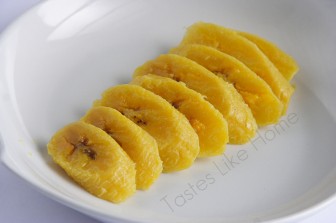Hi Everyone, When it comes to food, I do not have secrets. If you want to know how I’ve made something, I’ll gladly tell you. Yet, my best friends and more recently my extended family accuse me of “doing secret things” when it comes to cooking. Their reasoning is simple. The things never turn out the way I tell them to make it, therefore, there must be some secret ingredients or methods that I employ when cooking.
Case in point: Last week Sunday I gathered the family for lunch. One of the side dishes on the menu was boiled ripe plantains. Everyone, and I mean everyone, raved about the plantains and kept asking me what I did, how I prepared the plantains. I explained, “Remove the top and bottom tips of the plantains, leave the skin intact, add the plantains to a pot, fill the pot with water to just cover the plantains and boil it until it cooks. You will know that the plantains are done when the skin splits half way or all the way down. Drain the plains and add it back to the pot covered and let cool until easy to handle or you are ready to serve it. The skin peels away easily and you can then cut it into rounds or diagonally, on the bias.”
Many people were shocked that that was all I did. I swear that was exactly what I did. Frankly, I was surprised by how taken in they were by such a simple thing and at the same time I was curious as to their reaction to the actual taste of the boiled ripe plantains. I then came to the conclusion that whenever they cooked or ate ripe plantains, it was always pan fried, placed into a soup or mettagee or boiled and fried. Having the plantains boiled plain allowed for the natural sweetness and flavour of the plantain to shine through. People begged for further details and I obliged.
We all know that plantains have various levels of ripeness. There is the turning plantain – this is where the plantains get a beautiful light yellow coloured skin but the top and bottom tips are a mild green. Then there is the ripe plantain, where the skin is a deep yellow-cream colour the top and bottom tips dark and there may be some streaks of darkness on the skin. And finally, we have the very ripe plantain. At this stage the skin of the plantain is a combination of mostly dark skin with dull shades of yellow-cream all over. The top and bottom tips are black. A plantain at each of these levels of ripeness will yield a different texture and varying degrees of sweetness. The plantains I used for the meal last Sunday were ripe plantains.
The only “secret” thing I did, if you can call it that was to add a teaspoon of salt to the plantains once the pot came to a boil. I added the salt because I figured that it would help to boost the sweetness of the plantains. It’s the same reason that people add a bit of coffee to certain chocolate desserts to boost the flavour.
One of my cousins then explained that what he found appealing about the plantains was the way they were presented, specifically, how they were cut, on the bias. “Ah ha!” I exclaimed. “Now we’re on to something. I always tell people that one of the many things they can do to make food appealing is to present the food in a different way. The presentation can be how the food is cut, shaped or moulded or it could be the vessel in which you serve the food. Everyone knows that we eat with our eyes first.” I saw many people nodding.
If you want to make things fancy, then you can opt to serve the plantains with an herbed butter that melts over the hot, sweet ripe plantains. Oh gosh, the buttery-creamy-saltiness of the butter glazing the sweet flesh of the ripe plantains is a mouthful of joy. The herbs, preferably, thinly sliced green onions (shallots) lend a gentle herby, subtle onion flavour.
Without further ado, I give to you Boiled Ripe Plantains.

Boiled Ripe Plantains
Ingredients
3 pounds ripe plantains
Water
1 teaspoon salt (optional)
Directions
1. Cut off the top and bottom tips of the plantains.
2. Add the plantains to a large pot and add water to just cover the plantains.
3. Cover the pot, place on high heat and bring to a boil. When the pot comes to a boil, stir in the teaspoon of salt, if using. Let plantains cook until the skin splits half way.
4. Drain in a colander; add back plantains to pot and leave covered until ready to serve. Or, if you would like to serve the plantains hot with some butter, then remove skin and cut plantains and serve with knobs of butter. Be careful, as the plantains will be very hot.





